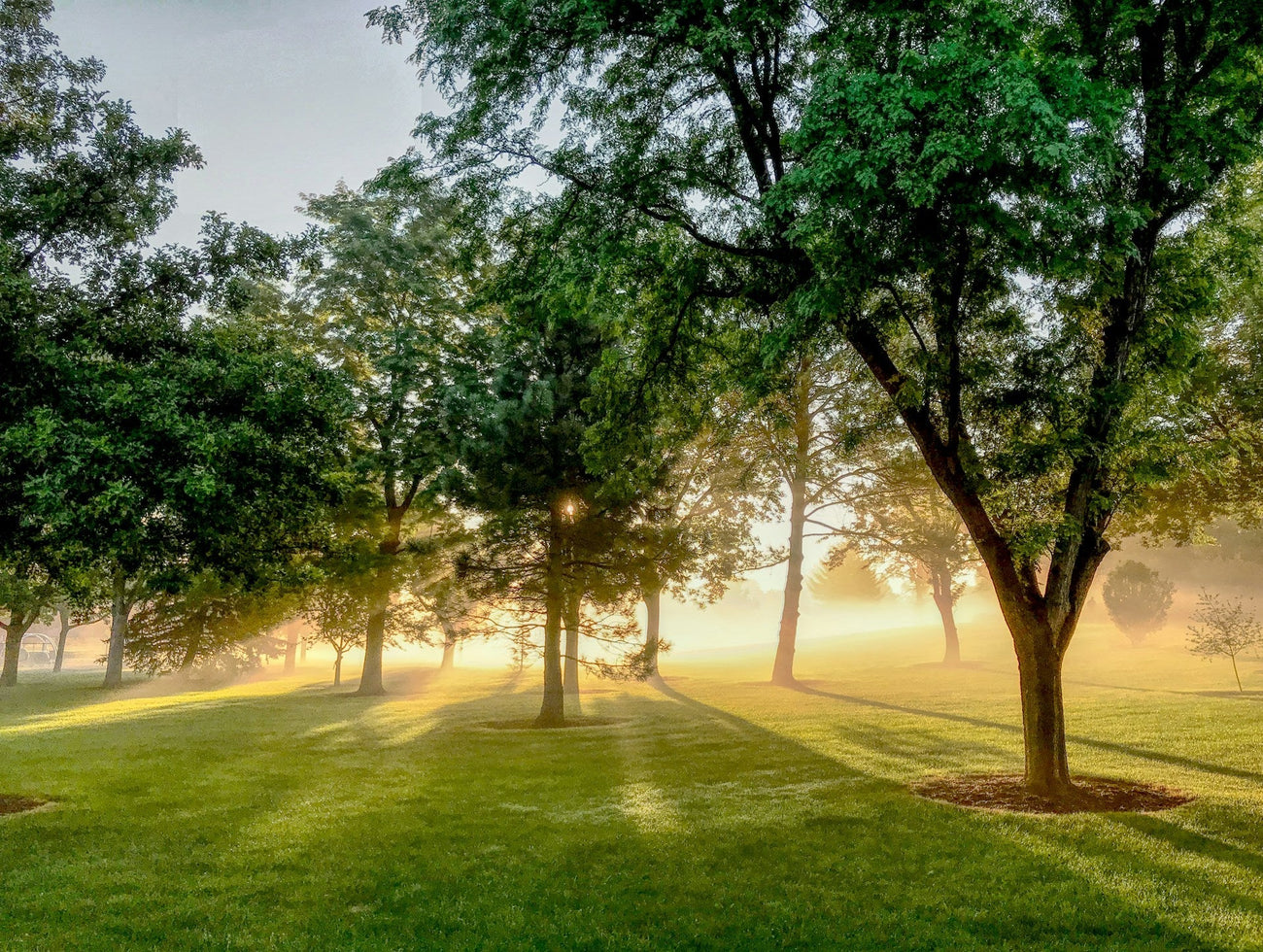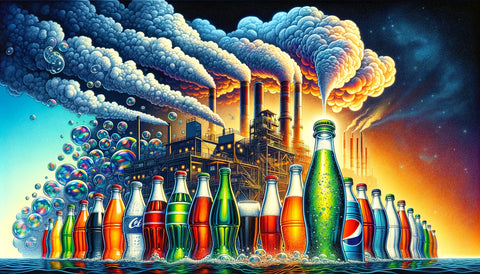
How Our Organic CO2 Helps Reduce Carbon Footprints

Welcome to a fizzy revelation! Ever wondered about the CO2 in your homemade soda? At Soda Sense, we take that thought seriously and turn it into our mission. We serve up bubbles with a conscience, ensuring your soda indulgence doesn't leave a carbon footprint bigger than Sasquatch's. Our organic CO2 isn't just about great-tasting soda, it's about making a difference. So how do we manage this fizzy feat? Lean in and let's pop the lid on this carbonated conundrum.
What is the difference between organic CO2 and non-organic CO2?
Carbon dioxide is a simple molecule and there is no chemical difference between "organic" CO2 and CO2 produced from other sources. It is important to note that this usage of "organic" is not the same as in organic chemistry, where it refers to compounds containing carbon bonded to hydrogen.
Regular CO2
At its core, the compound CO2 is made of is composed of one carbon atom and two oxygen atoms. It's colorless and odorless, and its presence is vital for many of Earth's processes. CO2 is a byproduct of respiration in animals and humans, and it's absorbed by plants for photosynthesis, making it an integral part of the biological carbon cycle.
It's also released into the atmosphere through natural processes like volcanic eruptions and through human activities, such as deforestation and burning fossil fuels. While CO2 is essential for life on Earth, an excessive increase in its atmospheric concentration due to human activities is implicated in global warming, making management of its sources and levels crucial.
Organic CO2
Organic CO2, here in the context of Soda Sense, refers to CO2 derived from renewable resources within the agricultural sector in the United States. Just like regular CO2, organic CO2 is a compound made up of one carbon atom and two oxygen atoms.
What sets it apart is its source — organic CO2 is not created by burning fossil fuels but instead is captured as a byproduct of certain agricultural processes. It's part of a balanced carbon cycle, essentially borrowing CO2 from existing natural resources and returning it back into the ecosystem, thereby avoiding any additional greenhouse gas emissions.
Which Soda Has the Most Carbon Dioxide?
Typically, standard colas like Coca-Cola and Pepsi contain more carbon dioxide compared to other sodas. However, the amount of CO2 in a beverage can vary depending on the brand and specific product line.
It's also important to note that the perception of 'fizziness' is not solely dependent on the actual CO2 content. Other factors such as temperature, sugar content, and even the size of the bubbles can influence the perceived level of carbonation.
How Is CO2 Made For Soda?

If you're wondering how CO2 is produced for soda, the answer is simple: CO2, or carbon dioxide, for the soda industry is produced mainly through industrial processes. This involves capturing the gas emitted during the manufacturing of certain chemicals or the burning of fossil fuels. The CO2 is then purified and compressed into storage cylinders for use in soda makers. While this method is the most common, it isn't the only way to source CO2.
An alternative method, which we at Soda Sense are particularly passionate about, is the production of organic CO2. This method involves utilizing renewable resources within the agricultural sector, minimizing environmental impact.
How Organic CO2 Helps Reduce Carbon Footprints
When you use Soda Sense's organic CO2, you're actively participating in a sustainable carbon cycle. Rather than contributing to the extraction and burning of fossil fuels, which adds new CO2 to the atmosphere, you're using CO2 captured from agricultural processes. This "borrowed" CO2 is already part of the ecosystem and will be returned to it, minimizing your carbon footprint.
Furthermore, by choosing a U.S.-based company that prioritizes local operation, you avoid the carbon emissions associated with international shipping. It's a small choice that adds up, allowing you to enjoy your fizzy drinks, knowing you're making a thoughtful, environmentally-conscious decision.
Related Read: 10 Ways to Be More Eco-Conscious
What Are CO2 Farms?
CO2 farms are an innovative and eco-friendly approach to producing carbon dioxide. They are facilities that intentionally cultivate crops or other biomass specifically for the purpose of carbon capture. As these plants grow, they absorb CO2 from the atmosphere during photosynthesis. Once the biomass is harvested, it is processed in a way that captures the CO2 for use, such as in our soda makers' canisters.
In essence, CO2 farms are a means of recycling carbon dioxide already present in the ecosystem, rather than adding new CO2 to the atmosphere. Soda Sense is proud to source its CO2 from these renewable resources, maintaining a balanced carbon cycle without contributing to additional greenhouse gas emissions.
Related Read: How to Support Local Farms Through Organic CO2
The Soda Sense Refill Club
Our Soda Sense refill process capitalizes on the principles of recycling and resource conservation, ensuring a seamless yet sustainable experience. When your CO2 canisters are empty, simply place them in the box they arrived in and use the pre-paid shipping label to send them back to us. This easy exchange system is not just convenient, but it also reduces waste by reusing the canisters.
Once you seal your box, all that's left to do is hand it to your mailman! The second USPS scans your shipping label, the team here in Seymour, WI is notified of your order and automatically sends you 2 new canisters that same day. Remember, all this happens within the USA, cutting back on the carbon emissions typically associated with international shipping. Our refill process underscores our commitment to your soda enjoyment, your convenience, and our planet's well-being.
Does Soda Sense Refill My Exact Canisters?
No, Soda Sense does not refill your exact empty canisters that are shipped in. However, rest assured that every canister sent back to us is thoroughly cleaned, refurbished, and repurposed for future orders. This practice aligns with our commitment to sustainability and reducing waste.
Our patented shipping process, meticulously designed to deliver the fastest service on the market, involves sending you two fresh canisters as soon as we are notified of your return shipment. This ensures that you receive your refill as quickly as possible, minimizing the time you spend without your favorite fizzy drinks.
Related Read: How Can I Refill My Empty Quick Connect CO2 Cylinders from SodaStream?
Myths About Carbon Dioxide
There is a myriad of misconceptions surrounding carbon dioxide, particularly in the context of its use in soda makers and its impact on the environment. In this section, we aim to debunk some common myths and provide a clearer understanding of CO2's role in our ecosystem and in your fizzy drinks.
All CO2 Is Bad for the Environment
Contrary to common belief, not all CO2 is detrimental to the environment. In reality, CO2 plays a vital role in the natural carbon cycle, supporting plant life and, consequently, oxygen production. The concern arises when excessive CO2, typically emitted from burning fossil fuels, is released into the atmosphere, leading to global warming. However, Soda Sense's organic CO2 is sourced from renewable resources, ensuring it does not contribute to these harmful emissions.
There Is a Chemical Difference Between Organic and Regular CO2
The term "organic" in reference to organic CO2 might suggest a chemical distinction from regular CO2. However, this is a misconception. The disparity lies not in the chemical makeup of the gas, but rather in its source. Organic CO2 is obtained from renewable resources, playing a role in maintaining a balanced carbon cycle and mitigating greenhouse gas emissions.
Using Refilled CO2 Canisters Is Unsafe
Some might worry about the safety of using refilled CO2 canisters, but this concern is unfounded with Soda Sense. All returned canisters are thoroughly cleaned, refurbished, and rechecked for safety before being repurposed. Therefore, you can enjoy your fizzy drinks without any safety concerns.
The Importance of CO2 in Our Daily Lives

CO2 is often discussed for its role in climate change and global warming, but this gas also holds a significant place in our daily lives. Beyond its environmental role, CO2 is an essential part of various industries such as food and beverage, pharmaceuticals, agriculture, and more. In the food and beverage industry, for instance, CO2 is used for carbonation in soft drinks and beer.
It also serves as an excellent preservative, maintaining the freshness of packaged foods. In the medical world, CO2 is used in various applications, including respiratory stimulation during and after anesthesia, cryotherapy, and laser surgeries.
In the realm of agriculture, CO2 plays an irreplaceable role in the growth and development of plants. By utilizing CO2 in controlled environments such as greenhouses, farmers can enhance crop yield and quality. When it comes to Soda Sense, we harness the power of CO2 for home soda makers, allowing you to create delicious fizzy drinks from the comfort of your home.
While we utilize CO2, we do so responsibly, sourcing our CO2 from renewable resources and operating an efficient refill system that reduces waste and emissions. This way, you can enjoy the benefits of CO2 in a sustainable manner.
Join the Bubble Movement Sustainably
The Soda Sense Team strives to be the frontrunner in promoting sustainable practices in the world of at-home soda makers. Through the use of organic CO2 derived from renewable resources, we aid in maintaining a balanced carbon cycle, without contributing to harmful greenhouse emissions. By sourcing its CO2 domestically, the company minimizes the carbon footprint associated with international shipping.
Furthermore, our Soda Sense Refill Club ensures convenience for the consumer while aligning with the principles of recycling and resource conservation. Lastly, this article debunks common myths about CO2, providing a clearer understanding of its role in our ecosystem and in your fizzy drinks. Join us in our pursuit of convenience wrapped in sustainability and let's make a difference, one fizzy drink at a time.
Recommended reading

How to Give Back During Thanksgiving 2025
Key takeaways Thanksgiving is a time to express gratitude and share with those in need. From volunteering at local shelters to donating food and essentials, there are numerous ways to give back to...

What Does Carbonation Do to Your Body?
What does carbonation do to your body? Carbonation alone typically has minimal effects; however, it can cause bloating and discomfort for some, and it may worsen acid reflux due to carbon dioxide ...

What Are the Health Benefits of Sparkling Water?
Summary Sparkling water isn't just a refreshing drink—it comes with surprising health benefits too. From aiding digestion to improving hydration, discover how sparkling water can be a healthy addi...